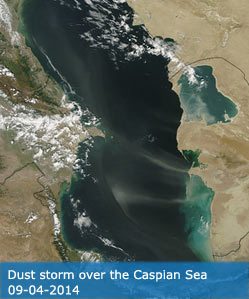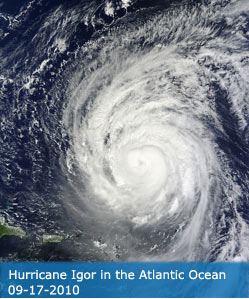Images
November 4, 2022 - Lake Michigan in Bloom
Tweet
Milky turquoise swirls tinted the southern tip of Lake Michigan on November 1, 2022, when the Moderate Resolution Imaging Spectroradiometer (MODIS) on board NASA’s Terra satellite acquired a true-color image of the third-largest Great Lake. The bright colors extend near the coastline from Milwaukee, Wisconsin, in the west to Benton Harbor, Michigan in the east. In addition, a cloud of lighter-toned hues color deeper water in the southeastern section of the lake, roughly from Muskegon, Michigan to La Porte, Indiana.
The color most likely comes from a combination of sediment and phytoplankton. At the start of October, the waters of southern Lake Michigan appeared dark blue and were nearly free of jewel-toned stains. A series of cloudy days with gusty wind kicked up sediment near the southern shores, especially from October 16-18, leaving the southern coastal waters tinted muddy brown on October 19. Over the next few days, the sediment was carried eastward and into deeper waters. The color of sediment changes from tan to greenish or blue-green as it sinks below the surface.
Now, almost two weeks after the cold and gusty front moved over the lake, the color along the shoreline has thinned while the color in the deeper water has expanded. This strongly suggests that phytoplankton, which live in the lake year-round, have taken advantage of the extra nutrients provided by the stirred-up sediment and have begun to reproduce explosively to create a large bloom.
Phytoplankton are microscopic algae which contain the pigment chlorophyll and float freely in the sunlit upper layers of marine environments, including the Great Lakes. Blooms are most common in the spring and summer in the Great Lakes, when water is warm and daylight is long. However, late-season blooms can occur, especially when nutrients become plentiful.
Image Facts
Satellite:
Terra
Date Acquired: 11/2/2022
Resolutions:
1km (218.6 KB), 500m (610.5 KB), 250m (1.3 MB)
Bands Used: 1,4,3
Image Credit:
MODIS Land Rapid Response Team, NASA GSFC
Tweet
Milky turquoise swirls tinted the southern tip of Lake Michigan on November 1, 2022, when the Moderate Resolution Imaging Spectroradiometer (MODIS) on board NASA’s Terra satellite acquired a true-color image of the third-largest Great Lake. The bright colors extend near the coastline from Milwaukee, Wisconsin, in the west to Benton Harbor, Michigan in the east. In addition, a cloud of lighter-toned hues color deeper water in the southeastern section of the lake, roughly from Muskegon, Michigan to La Porte, Indiana.
The color most likely comes from a combination of sediment and phytoplankton. At the start of October, the waters of southern Lake Michigan appeared dark blue and were nearly free of jewel-toned stains. A series of cloudy days with gusty wind kicked up sediment near the southern shores, especially from October 16-18, leaving the southern coastal waters tinted muddy brown on October 19. Over the next few days, the sediment was carried eastward and into deeper waters. The color of sediment changes from tan to greenish or blue-green as it sinks below the surface.
Now, almost two weeks after the cold and gusty front moved over the lake, the color along the shoreline has thinned while the color in the deeper water has expanded. This strongly suggests that phytoplankton, which live in the lake year-round, have taken advantage of the extra nutrients provided by the stirred-up sediment and have begun to reproduce explosively to create a large bloom.
Phytoplankton are microscopic algae which contain the pigment chlorophyll and float freely in the sunlit upper layers of marine environments, including the Great Lakes. Blooms are most common in the spring and summer in the Great Lakes, when water is warm and daylight is long. However, late-season blooms can occur, especially when nutrients become plentiful.
Image Facts
Satellite:
Terra
Date Acquired: 11/2/2022
Resolutions:
1km (218.6 KB), 500m (610.5 KB), 250m (1.3 MB)
Bands Used: 1,4,3
Image Credit:
MODIS Land Rapid Response Team, NASA GSFC




